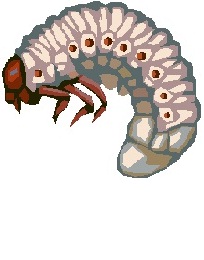 White Grubs in the Garden - July 13, 2011 Jeff Schalau, Agent, Agriculture & Natural Resources University of Arizona Cooperative Extension, Yavapai County White grubs are the larval stage of insects commonly known as scarab beetles. This group includes June beetles, masked chafers, and dung beetles. Arizona has many species of scarab beetles, most of which do not cause significant economic damage to crops or horticultural plantings. A few species, however, commonly damage turfgrass and other cultivated plants. Most landscape professionals associate white grubs with lawns where they are often a pest. Here, they eat tender turfgrass roots causing a gradual thinning and weakening of the stand. Damage may progress from thinning to small patches of dead grass to the sudden wilting of the grass even with adequate soil moisture. Aside from turf damage the grubs cause directly, their presence in high numbers can attract birds (starlings and grackles) and mammals (skunks and raccoons) that can cause further damage as they dig in the turf in search of the grubs for food. Turf managers often try to mitigate this damage by treating white grub infested areas with insecticides. However, not all white grubs are “bad”. With increasing interest in vegetable gardening, the Cooperative Extension office has received white grub samples which were associated with horse manure or compost. Under these conditions, the white grubs are providing a service by breaking down the cellulose in your gardens and potted plants converting it into nutrients needed by your plants. Furthermore, some of these grubs are not the ones that feed on the roots or crowns of your plants and do not need to be killed. One such beneficial white grub is the Bumble Flower Beetle (Euphoria inda) so called because of the buzzing sound they make when the adults fly. The adults emerge in the fall to feed. The adults overwinter in the soil. You will see them flying again in the spring when they search out decaying wood, piles of manure and other rotten plant debris in which they lay their eggs. Some gardening forums refer to the white grubs in compost as Japanese beetle larva and recommend you treat them with pesticides. We do not have Japanese beetles in Arizona (yet), so I would not recommend treating decaying organic matter with pesticides. We do have the green fig beetle of which the adults can feed in great numbers on ripening peaches and nectarines. Some of the posts on garden forums also recommend the use of Milky Spore Disease to kill these white grubs even though this material is not an effective control option for the scarabs we have in the western United States. You can discern some species of white grubs by looking closely at the last abdominal segment of the white grub with a hand lens. Ohio State University has an excellent color publication on the various white grubs and their hind ends (see link below this column). Pick up the white grub, flip it over on its back. You are looking for the arrangement of spines and hairs on the last abdominal segment called the rastar. These spines and hairs form a distinctive pattern on all white grubs other than the bumble flower beetle. The bumble flower beetle grub is also common in container grown plants feeding on wood chips, bark mulch, peat moss, and other dead organic matter. The grubs rarely damage plant roots. Like green fig beetles, adult bumble flower beetles feed on flowers, ripe fruits such as apples, pears, peaches, grapes, and on sap exuding from tree wounds. Bumble flower beetles are also reported to injure corn in the milk stage although this problem is seldom reported. Poultry can be an excellent biological control for white grubs in compost and manure. Simply allow them access and they will scratch and eat all the white grubs in their path. Increasing numbers of vegetable gardeners are learning that poultry can complement the home garden in multiple ways. Otherwise, larger white grubs can be sieved or handpicked from compost before it is incorporated in the garden. Follow the Backyard Gardener on Twitter – use the link on the BYG website. If you have other gardening questions, call the Master Gardener line in the Camp Verde office at 928-554-8999 Ext. 3 or e-mail us at cottonwoodmg@yahoo.com and be sure to include your name, address and phone number. Find past Backyard Gardener columns or provide feedback at the Backyard Gardener web site: http://cals.arizona.edu/yavapai/anr/hort/byg/. Additional Resources White Grubs, (Utah State University Cooperative Extension) http://extension.usu.edu/files/publications/factsheet/white-grub07.pdf |